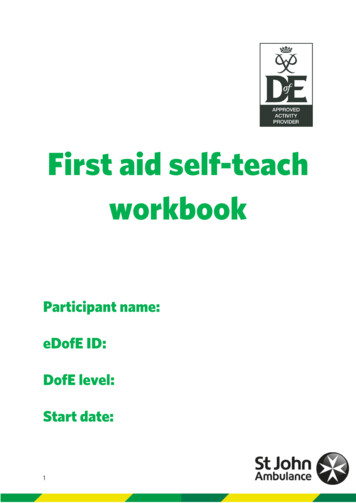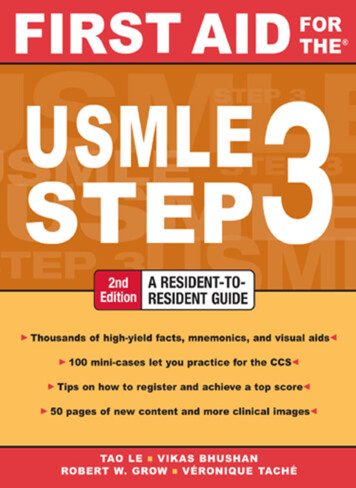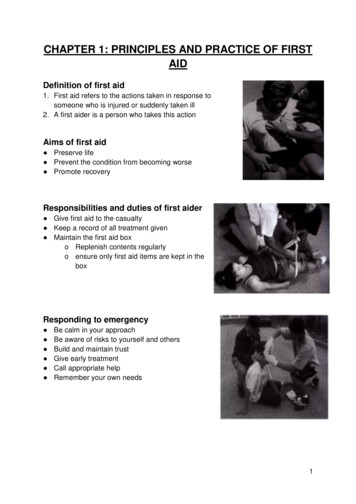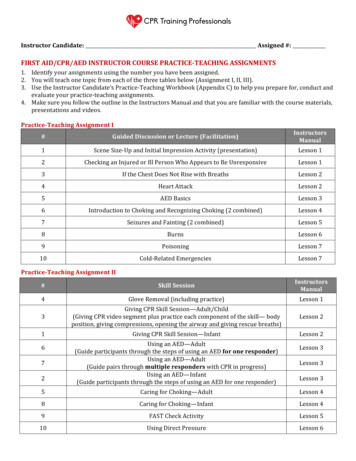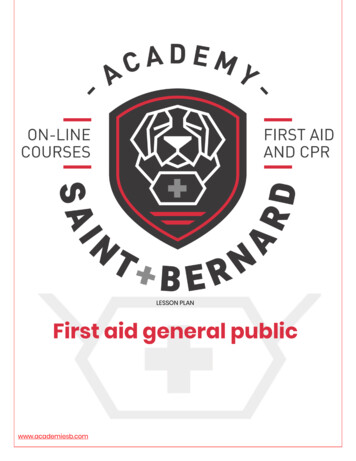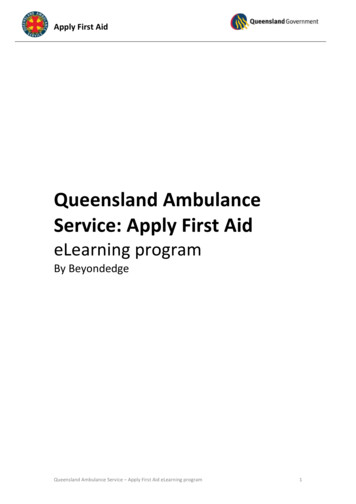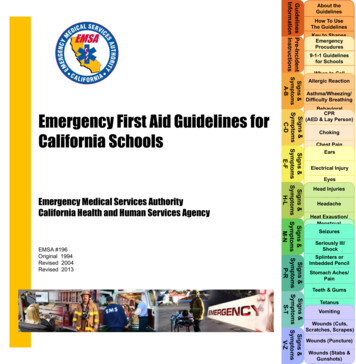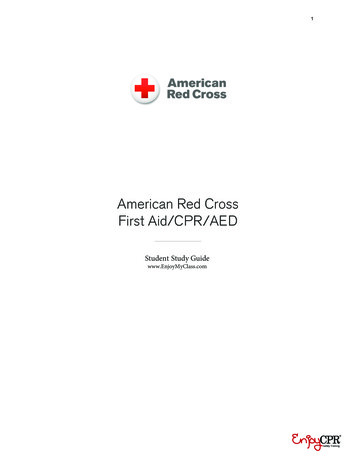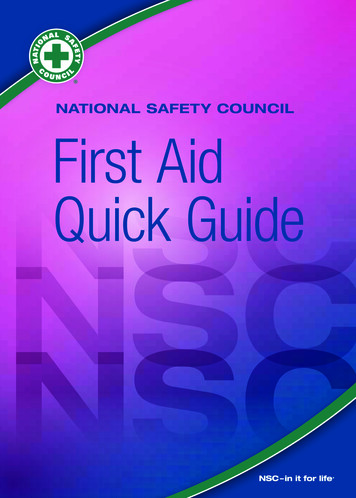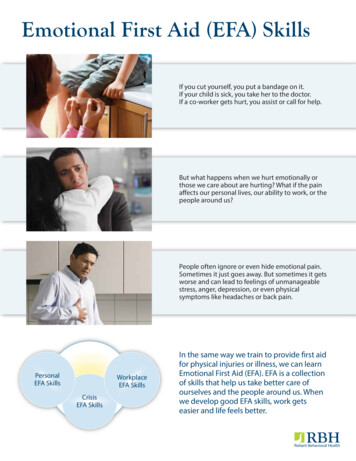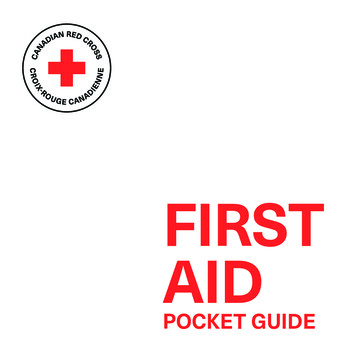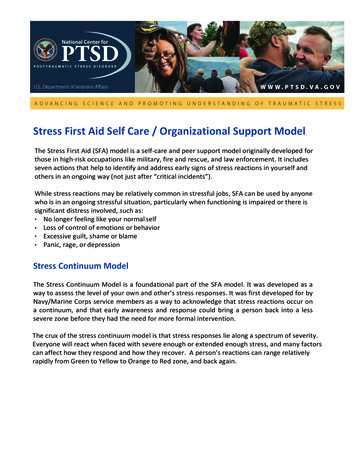
Transcription
Stress First Aid Self Care / Organizational Support ModelThe Stress First Aid (SFA) model is a self-care and peer support model originally developed forthose in high-risk occupations like military, fire and rescue, and law enforcement. It includesseven actions that help to identify and address early signs of stress reactions in yourself andothers in an ongoing way (not just after “critical incidents”).While stress reactions may be relatively common in stressful jobs, SFA can be used by anyonewho is in an ongoing stressful situation, particularly when functioning is impaired or there issignificant distress involved, such as: No longer feeling like your normal self Loss of control of emotions or behavior Excessive guilt, shame or blame Panic, rage, or depressionStress Continuum ModelThe Stress Continuum Model is a foundational part of the SFA model. It was developed as away to assess the level of your own and other’s stress responses. It was first developed for byNavy/Marine Corps service members as a way to acknowledge that stress reactions occur ona continuum, and that early awareness and response could bring a person back into a lesssevere zone before they had the need for more formal intervention.The crux of the stress continuum model is that stress responses lie along a spectrum of severity.Everyone will react when faced with severe enough or extended enough stress, and many factorscan affect how they respond and how they recover. A person’s reactions can range relativelyrapidly from Green to Yellow to Orange to Red zone, and back again.
Stress First Aid Self-Care / Organizational Support Modelwww.ptsd.va.govFigure 1: The Stress Continuum ModelNash, W. P. (2011). US Marine Corps and Navy combat and operational stress continuum model: A tool forleaders. Combat and operational behavioral health, 107-119.The internal or external stigma associated with reacting to stress can result in someone trying toconceal stress reactions from peers and those at work, to avoid perceived judgment,employment consequences, and/or medical or psychological intervention. However, when aperson recognizes the signs of orange zone stress in themselves or others around them, it canoften make a difference to be more disciplined about self-care for a period of time, or to supporta coworker or get them connected with a trusted support. This may help prevent stress reactionsfrom progressing into the Red Zone.Four types of stress are most likely to move someone into the orange zone. Generally, enteringthe orange or red zones are the result of a combination of the four following types of stressors: Life Threat: life-threatening or other situations that provoke terror, horror or helplessness.This type of injury can include experiencing a near-miss or close call, or witnessing orhearing about the life-threatening experiences of others. Loss: grief due to the loss of close coworkers, leaders, family members, people we feelresponsible for, or other cared-for individuals. This can also include loss of role,functioning, relationships, and values. Inner Conflict: a sense of inner turmoil due to conflict between one's moral/ethical beliefs andcurrent experiences. Inner conflict can result from acting outside of internal, self-imposedmorals or values, or the perception of contributing to or being unable to prevent harm toothers. Indications for inner conflict include the words: “could’ve,” “should’ve,” “ought tohave,” “why me?” or “if only.” Wear and Tear: the result of fatigue and accumulation of prolonged stress, including from nonoperational sources, without sufficient sleep, rest and restoration.VA National Center for PTSDMarch, 2018Page 2 of 18
Stress First Aid Self-Care / Organizational Support Modelwww.ptsd.va.govThe Stress First Aid Model’s Core ActionsStress First Aid is based on a set of five evidence-based elements that have been linked to betterfunctioning after stress and adversity across a number of settings, including safety (cover),calming, connectedness, self-efficacy (competence), and hope (confidence). Two additionalactions, Check and Coordinate, were added, which should be performed in an ongoing way tomonitor and recruit assistance any time a person is showing persistent Orange Zone reactions. Incontrast, the other five SFA actions are used only as needed.CheckThe Check action in SFA involves increased awareness about stress reactions in yourself and yourcoworkers in an ongoing way, whether stressors at work or at home cause them. The Checkaction often begins with awareness that you or another individual has been exposed to specificstressors. However, what triggers the sequence of Checks that initiate SFA are not necessarilythe events themselves but indications that you or someone who has been exposed to theseevents is functioning in the Orange or Red Zone.The Check strategies include both those for self-care and for checking on others. The table on thenext page includes some self-awareness stress indicators common to workers in high stressenvironments.VA National Center for PTSDMarch, 2018Page 3 of 18
Stress First Aid Self-Care / Organizational Support Modelwww.ptsd.va.govStress IndicatorsChange in eating habitsChange in weightLoss of will powerLosing interest / apathyCan’t hold a conversationExcessive guiltTaking lots of time offDrinking moreConflict in relationshipsFatigue / more sleepDon’t give self break(leaders) Changes in relationships Loss of controlNo longer feeling like selfCan’t get tasks doneCan’t think clearlyThings excessively piling upIsolating selfFeeling overly busy, hurriedPhysical changesGoing through the motionsMemory problemsPost traumatic stress symptomsDepressive or anxiety symptoms“I have made a very conscious effort to keep tabs on myself. The big stress indicators for me arefatigue, having a hard time focusing, being short on the fuse, not exercising, and not doing the things Ilike, but instead staying in and watching television.”Examples of Check strategies to use when checking on others include: Pick the right place and time to talk.Begin with a casual two-way communication to get someone talking.Find the right way to check on someone without annoying them (i.e., writing an email or textingversus calling or talking in person).Check in on anniversaries or reminders of events that were particularly hard.“One of the key points of check is knowing your people, and spending time with them. Thenyou can recognize those subtle changes. What I've done is to start a conversation aboutanything except what I think might be bugging them, and then I actively listen. And onceagain I'm talking the floodgates open, and it goes well.”OSCARMany people feel uncomfortable asking others about their stress reactions. We know how to havecasual conversations with peers, but when it comes to discussing personal issues or emotions, peopleoften don’t know where or how to start. Another common barrier to accurate assessment is the almostautomatic denial of experiencing any stressors, distress, or changes in functioning. One tool that can beeffective in overcoming these obstacles is “OSCAR” communication—a mnemonic (memory device) forthe five steps.VA National Center for PTSDMarch, 2018Page 4 of 18
Stress First Aid Self-Care / Organizational Support Modelwww.ptsd.va.govOSCAR Steps: Observe State Observations Clarify Role Ask Why RespondHere’s how it works: you have observed a co-worker keeping to themselves after a stressful event,such as the death or injury of another member of the department. You approach the withdrawn personand strike up a friendly conversation. After a while, you ask something open-ended like “It’s been ahard time lately. How are you doing? or “How are you feeling?”If he or she quickly brushes you off with a denial such as “I’m fine,” you could next state yourobservation, such as “Well, I asked because I noticed you’ve been keeping to yourself a lot lately.”Before the individual has a chance to get defensive, you add—to clarify your role—that you only bringit up because you are concerned, and want to know if there is any way that you can help.If you can then establish a common perception about the person’s behavior (i.e. he or she admits toisolating more than usual), you next ask why, or maybe simply “What’s going on?” (If the personcontinues to deny problems, then you will acknowledge that they say they are doing okay, but ask ifyou can check in with them later.)The final step is to respond with a statement that makes it clear that you both heard and understoodwhat you were told, and that you might have some ideas about what might make the person feel orfunction better.CoordinateThe Coordinate action in SFA involves getting any additional information and assistance thatmight be needed. This could involve consulting with and collaborating with others, or informingthose who need to know. Confidentiality may be challenging when using the Coordinate action,so you may need to ask for advice from those in your organization as to the most appropriateways to refer for care or inform others in your setting.Here are a few Coordinate strategies: If needed, try to find the most acceptable way to refer someone to EAP or other support, and givethen a possible menu of vetted options, rather than telling them to talk to someone. Be aware of local and national resources, such as:“We have a contact list with information, and§ Peer support teams§ Local counselorsoptions, so you have names of people you§ Chaplainscould contact easily.” them, and then I§ Others who have been through similaractively listen. And once again I'm talkingsituationsthe floodgates open, and it goes well.”VA National Center for PTSDMarch, 2018Page 5 of 18
Stress First Aid Self-Care / Organizational Support Modelwww.ptsd.va.govNOTE: If an individual indicates that he or she wants to harm themselves or others itshould be reported to 911 immediately. Be prepared to provide name, location, and cellphone number. Stay with the individual physically or on line until help arrives. If possible,call the National Suicide Prevention Lifeline at 1-800-273-8255 to speak to a crisiscounselor.CoverTo provide Cover means to ensure ongoing safety, usually performed more for others ratherthan yourself. It can be a momentarily provision of assistance that increases your or another’ssense of safety, or it could be a longer-term provision of safety via a greater commitment toorganizational safety and order.One way to open a conversation about Cover is to ask a simple question about the impact on theperson’s safety, or their preferences for regaining a sense of safety, including:§ How has the incident affected your sense of safety?§ What would help you to feel safe?Here are a few self-care Cover strategies, gathered from people in high-stress jobs: Find those people, places, or actions that feel safe to you and call on them when you need to feelmore of a sense of safety.When you feel unsafe, distract yourself by focusing on something near you or your own breath orthought (i.e., counting).Realize that no one is perfect and everyone is going to have strengths and vulnerabilities – beaware of your own.“To make myself feel more safe, I make contingency plans. I run through what I will do shouldsomething happen, for a whole variety of scenarios. It makes me feel better to know I have steps, and aplan, just like fire drills with kids in school. I have the same thing but for so many different scenarios. Ijust work it out in my head so I know what to do.”“When I’m in situations where I’m triggered, I try to step away and take a little time to relax, breath,and remind myself that every thing is okay, and it’s a safe situation. It usually works, but not always.It’s not 100%. When it doesn't work, immediately, if I am some place where I’m stuck and I can’t leave, Ido my best to get through it, and then as soon as I am able to leave, I practice stress-reducingtechniques.”Here are a few Cover strategies for use with others, gathered from people in high-stress jobs: Slowly implement SFA actions into your organization so it is normal well in advance of anythinghappening.VA National Center for PTSDMarch, 2018Page 6 of 18
Stress First Aid Self-Care / Organizational Support Model www.ptsd.va.govMake it a matter of policy to get people to feeling safe as soon as possible after a difficult workincident.Depending on what a person is doing and how they are responding, adjust communication withthat person to be more abrupt or directive if it’s necessary to keep them safe.Educate workers about the physiological response to orange zone stressors (life threat, loss, innerconflict, wear and tear), to minimize the lack of awareness of their own potential stress responses.After particularly impactful deaths or incidents, make a particular effort to discuss affected workerneeds and preferences.“Informal “debriefings,” or after-event reviews, are a good way to check on people, and also a goodway to make staff feel safe. We've all been through good post-incident discussions and bad ones. Thegood ones give people the opportunity to learn what is going through the mind of others who wereinvolved, and get a different perspective, without overwhelming people with emotions or making peoplefeel like they have to talk. Ultimately it's execution and facilitation that determines whether theseconversations are helpful.”Email from Facility Director:“The recent tragic events are continuous reminders of the security threats we face in our country andour facility. There are no easy answers to the current societal forces that perpetuate these threats, butwe can take local action to deter, mitigate and lessen the risk. I want to highlight some of the initiativeswe have put in place to make this a safer campus for our Veterans, Employees and visitors. Theseinitiatives target limiting after hours building access, deterring people from bringing weapons and drugsinto the facility, improving surveillance and providing more effective response to emergencies andthreats.Security is everyone’s responsibility. Let us know what is or isn’t working. Thanks for all you do everyday to serve our Veterans.”CalmThe goal of the Calm action in SFA is to reduce the intensity of physiological, emotional andbehavioral stress. There is overlap between the actions of Cover and Calm, but the difference isthat the primary goal of Cover is safety, and Calm actions may have no direct connection withsafety.One way to open a conversation about Calm is to ask a simple question about the need for calming, ortheir preference for calming actions, including:§§§What changes have occurred regarding sleep, feelings of being on edge, or ability to keep calm?What usually helps you to calm down?What would help you to feel more of a sense of calm?VA National Center for PTSDMarch, 2018Page 7 of 18
Stress First Aid Self-Care / Organizational Support Modelwww.ptsd.va.govHere are a few strategies for calming yourself, gathered from people in high-stress jobs: Engage in regular physical activity, yoga, or stretching.Spend time with family and close friends, and let them know what is calming for you ahead of timeso they can better support you when needed.Creative activities to adapt to stressors.Give time to yourself every day:o Taking a walko Listening to guided relaxation or musico Doing some deep breathingo Looking at photos of family or natureo Watching a funny videoHere are a few strategies for calming others, gathered from people in high-stress jobs: Explain what you have done to address similar reactions.Find others who have been through similar situations to provide support by mentoring.Give information about the context, skills or strategies that make the individual feel more informedand in control.Remind others of the importance of self-calming strategies.Empower, support and/or engage the other person in distracting activities.Acknowledge possible stressors and the potential need for support in a matter of fact way ahead ofdifficult events, even through humor.If a stressed person can’t make good decisions, communicate exactly what is needed in a calm,methodical voice.After workplace critical incidents, determine next steps for each person on a case-by-case basis.There will likely be different strategies for different contexts and events. For instance, for individualswho have suffered a loss, either on or off the job, these are some suggested strategies from individualswho have dealt with a loss in high-stress jobs: If you don’t know what to say, stay present, stay quiet and listen. There really is nothing to say, soit’s all about the supportive presence you provide.Don’t try to make a grieving person feel better, because there is no better way to feel at themoment. Just be there.When a person does want to talk with you about the loss, don’t feel compelled to talk. There are no“magic words.” Listen and provide support in the way that you think is going to be most acceptableto the grieving person.Check in over the next few months, to see how the individual is doing.If the loss affected more than one person, foster a sense of communal grieving with memorials,communal conversations and actions, and other ways to honor the loss, such as memorial funds,scholarships, or donations. Make sure participation is voluntary and that different ways ortimelines for coping with loss are honored.VA National Center for PTSDMarch, 2018Page 8 of 18
Stress First Aid Self-Care / Organizational Support Modelwww.ptsd.va.gov“Our staff experienced a workplace violence fatality, and the staff was allowed to stay. Others wereallowed to go home. Sometimes it helps for people to stay around and see what normal looks like, tosee someone who is coping well. For some people it's very comforting to see other people who wereinvolved in the situation, and be able to huddle and see how they are. For other people, they canactually make them feel worse if they were severely affected. I really think it is to be a case-by-case.Usually the person has a sense if they need to go home, but if they don't and you see them reallystruggling, know the person well enough to know that they need a task or something to do away fromthe situation or tell him or her to go home to get well rested sure what's coming. For some people itmay be the fifth thing that's happened that year, as well as things that happened in their childhood.There may be a whole historical background contributing to how they're reacting today.”ConnectThe Connect action of SFA involves restoring or increasing social support, such as asking for orproviding support when you see Orange Zone stress in yourself or others.One way to open a conversation about Connect is to ask a simple question about the need forconnection, or their preference for what is most helpful about connection, including: Has there been an impact on how you talk with each other, work morale, or connecting with familyand friends? Is there someone you feel comfortable talking with about this? Has anyone you know done or said something that really helped?Here are a few strategies for self-care related to connecting with others, gathered from people in highstress jobs: Seek out contact with your support system, even if far away Be open to different types of support Help others Maintain normalcy/routine in social activities Connect with others around honoring a critical incident, and/or around moving forward andresilience Discipline yourself to have conversations people who know you well enough to know whensomething is bothering you Reprioritize your schedule to spend more time with those who mean the most to youHere are a few strategies for helping others connect, gathered from people in high-stress jobs: Open communication with co-workers Electronic support, which is time limited and convenient Staff check-ins Staff down-time and support Staff latitude and flexibility Confidence in staff abilities from managersVA National Center for PTSDMarch, 2018Page 9 of 18
Stress First Aid Self-Care / Organizational Support Model www.ptsd.va.govShow of caringResilience building training / actionsAllow staff to check in with familiesIf someone has retreated because of an incident, find ways to indirectly include them in projectsand create collaborative opportunities with peers, to get them back into doing somethingmeaningful.Keep calling, texting, and talking with co-workers involved in a significant loss or traumatic workevent. Stress reactions often don’t surface for months or even years after a accumulation ofevents.“There was a fatality on the ward, and one of the staff felt irrationally responsible for not doing more tostop the death. We rallied around him as much as he would let us. He was a solitary kind of guy beforethe incident, so it would be normal for his reaction to be one of retreat. A year ago, I would have let himretreat, but because I was introduced to the SFA model, I rallied an effort to help. I included him indiscussions and team projects for which I would not have in the past. They benefitted from his expertise,and created collaborative opportunities with peers. It gave us the opportunity to include him, take histemperature from time to time. It redirected his energy to get him back to a sense of competence,confidence and connection, to get him back into doing something that was in his wheelhouseprofessionally. These actions have all the appearances of being effective.”CompetenceThe Competence action of SFA focuses on fostering and restoring a stress-affected person’scapacity to function in all his or her important life roles, including occupational, personal, andsocial domains.One way to open a conversation about Competence is to ask a simple question about the need for asense of self-efficacy, or their preference for what is most helpful to regain a sense of self-efficacy,including: Do you have any concerns about being able to handle what’s going on in your life, deal with yourstress reactions, or do your work? What are some things that you have done to cope that have been helpful in the past, or havebeen helpful since this incident? How can I/we help you feel more competent at work and/or with self-care?Here are a few strategies for building your own sense of competence, gathered from people in highstress jobs: If you’re under too much stress, do something that is easy for you to give you a sense ofaccomplishment. Be more disciplined in taking whatever healthy steps support you in dealing with stress. Regularly reflect on the balance between the satisfaction of fulfilling work duties and the personalsacrifices you are making. Be prepared to adjust behaviors and expectations if that balancechanges over time.VA National Center for PTSDMarch, 2018Page 10 of 18
Stress First Aid Self-Care / Organizational Support Modelwww.ptsd.va.govHere are a few strategies for building competence in others after critical events that affect more thanone staff member, gathered from people in high-stress jobs: Schedule regular morning check ins, and/or debrief regularly. Encourage more wellness breaks / time off. Schedule helpful trainings, workshops or “lunch and learns.” Allow for more flexibility on work scheduling. Sensitively address staff concerns. Regularly inform staff about organizational actions that help with safety issues or other concerns. Promote continual sharing of resources.Here are a few strategies for building competence when a person is in the orange or red zone, gatheredfrom people in high-stress jobs: Mentor others by figuring out how the person is going to best learn something, and potentiallyteach the same strategy to others. Give the stressed individual responsibility little by little, so that they are more and more in control,to build a past foundation so that when they are in a situation where serious mistakes couldhappen, they know that there is a high likelihood that they will be okay, and if they’re not, it’s notbecause they didn’t try. After mistakes, help the person become more competent, to help with shaken confidence. Remindthem that everyone is human, that all reactions are acceptable in the right context, and help themto figure out what they might do differently in the future. As a leader, if your staff’s sense of duty and commitment lead to over-working, make sure thatthey're getting rest, and advocate for them. Before you have a conversation with somebody who you think needs time off, make sure takingtime off is acceptable and feasible for that individual.“I think it goes back to that notion of how important it is to ask people what it is they need. And not justafter critical incidents I think that managers are key role models and influencers. I can’t highlightenough the importance of paying attention to and encouraging mentorship for those leaders as well.”“Pretty much everyone I see is burdened by work. We are out taking on more duties as our workforceshrinks and budgets shrink. I think a lot of people will offer “solutions” when they really don't know ifthose solutions are possible. To say you should take time off may be really tough for someone to do. Sobefore you have a conversation with somebody who you think needs time off you need to make surethat the option is acceptable and feasible for the person.”ConfidenceThe Confidence action of SFA may be a more challenging action to implement than the rest ofthe SFA actions, but it may also have the greatest impact for someone who has lost confidence inthemselves or others. The Confidence action involves promoting realistic hope and building self-VA National Center for PTSDMarch, 2018Page 11 of 18
Stress First Aid Self-Care / Organizational Support Modelwww.ptsd.va.govesteem that may have been damaged or lost as a result of stress, promoting confidence in corevalues and beliefs, or bolstering pride and commitment.One way to open a conversation about Confidence is to ask a simple question about the need for asense of hope, optimism, or confidence, or their preference for what is most helpful to regain a senseof confidence, including:§§§Do you have any changes in your confidence in:§ Your ability to do your job in the same way as before the incident?§ You ability to deal with the ramifications of the incident?§ The organization / leadership?Does this incident hold special meaning or connect with other experiences in any way?What could help you to feel more hope / confidence?Here are a few strategies for building your own confidence: Use small triumphs to build confidence. If you have self-doubt, talk with mentors, friends, orspiritual guides, or read more self-help books or articles.After particularly traumatic situations or losses, don’t push yourself to “process” the situation inany particular time frame, but if something triggers you, give yourself time and space to think itthrough, integrate it, talk to someone, have emotions, find ways to makes sure it doesn’t causeyou to get stuck in suffering, and / or make sense of it.Use the wisdom gained from hard experiences to reconfirm your values, make changes in your life,appreciate what you value, or help others.Here are a few strategies for building confidence in others after critical events, gathered from people inhigh-stress jobs: Support each other and remind each other of strengths. Focus on values, priorities. Take hope in the promises and commitments you’ve made, and what they say about you. Look to learn from each situation. Look for any hopeful or meaningful elements of the situation. Realize there will always be good days ahead. Cultivate hope from within so you can’t be shaken from the environment. Use faith / beliefs to feel supported in your undertakings.Here are a few strategies for building confidence or hope when a person is in the orange or red zone,gathered from people in high-stress jobs: If young staff members are struggling with confidence, give them tasks that they can be successfulat, solicit their opinions, set them up for success, or find some way they can contribute to the crew.If staff members show severe stress, talk with them, work with them, give them relevant readingmaterials, and connect them to people who have dealt with similar things. If they continue to gettriggered, mentor them to consider their options, including leaving the fire service.VA National Center for PTSDMarch, 2018Page 12 of 18
Stress First Aid Self-Care / Organizational Support Model www.ptsd.va.govIf a staff member is feeling bad about some reaction he/she had, help them counter their guilt bynormalizing their reactions, letting them know that they made the best decision they could havemade given what you knew at the time, and letting them know they are not alone in experiencingstress reactions.If a staff member’s confidence is low, or he/she feels no sense of purpose or contribution to theteam, point out a skill they have that does contribute to the team, or one of their other strengths.When stress starts to build up in the staff, explain to them why you’re doing what you’re doing, sothey don't lose confidence in the mission or leadership.“One of our clients took his own life, and one of the staff felt irrationally responsible for not doing moreto stop the death. We rallied around her as much as she would let us. She was introverted before theincident, so it would be normal for her reaction to be one of retreat.A year ago, I would have let her retreat, but because I was introduced to the SFA model, I rallied aneffort to help. I included her in discussions and team projects for which I would not have in the past.They benefitted from her expertise, and created collaborative opportunities with peers. It gave us theopportunity to include her, to better take her “well-being temperature” from time to time. It redirectedher energy to get her back to a sense of competence, confidence and connection, to
Stress First Aid Self Care / Organizational Support Model The Stress First Aid (SFA) model is a self-care and peer support model originally developed for those in high-risk occupations like military, fire and rescue, and law enforcement. It includes seven actions that help to identify an
